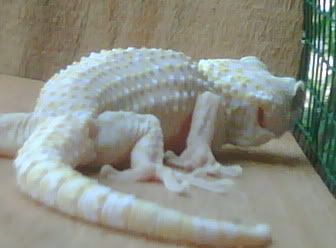daggekko
New member
before:

after 5 months

I drooled a lot. All over. Very nice!
before:

after 5 months

So, here is my Pied male, first two pics, and the possible Pied female, last two pics, that I've just paired him with.:wink:
I'm hoping to hit a common simple recessive pied gene here and get some visuals.
I drooled a lot. All over. Very nice!
Hello,
There seems to be old scars on the lower back which is typically from females fighting over territory. The easiest test is to look for or feel for the wax excretions from the pores that would surely be a male.
Please post photos again in a couple of months when she has been eating well and gone through a couple of sheds so we can see how nice she really is.
Enjoy.
What kind of this morph? Is it albino. But the eyes is not red color

What kind of this morph? Is it albino. But the eyes is not red color
What kind of this morph? Is it albino. But the eyes is not red color

wow nice tokay...look like T+
Sorry. What is meaning T+?

